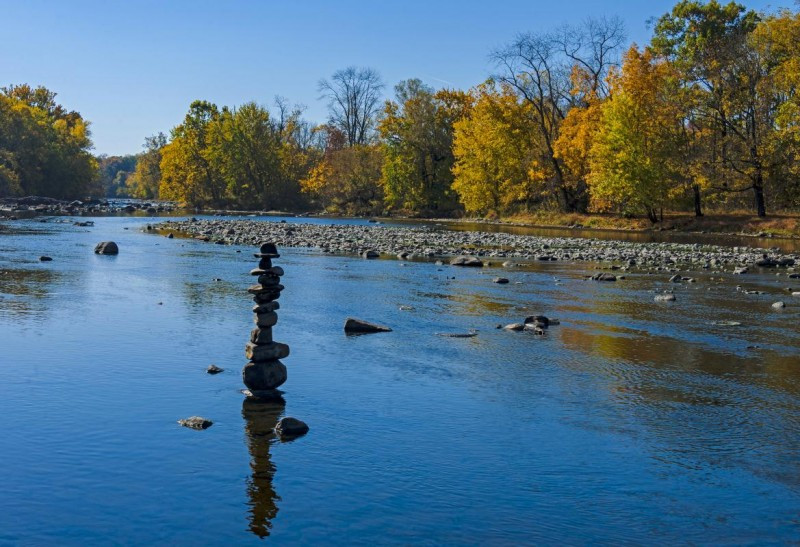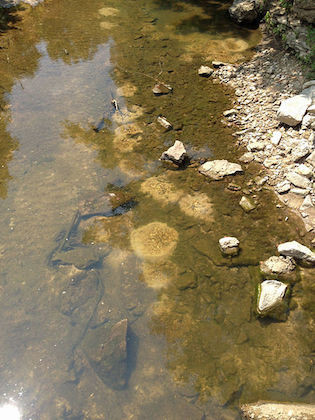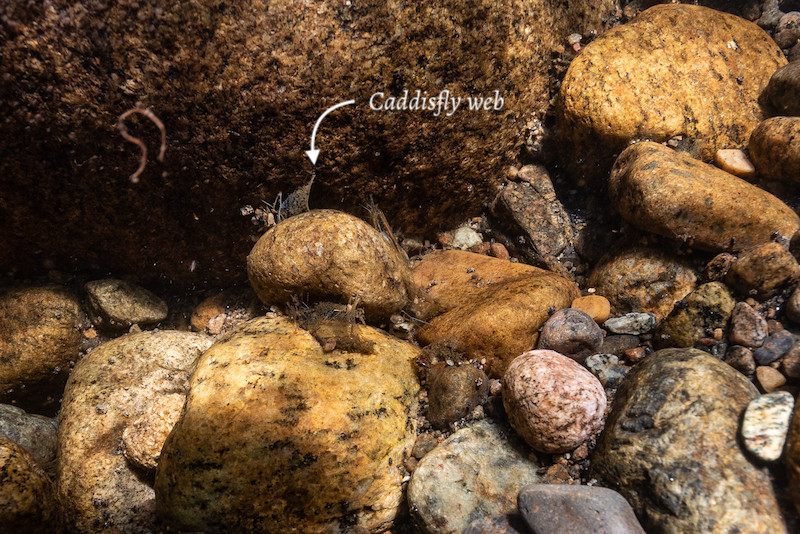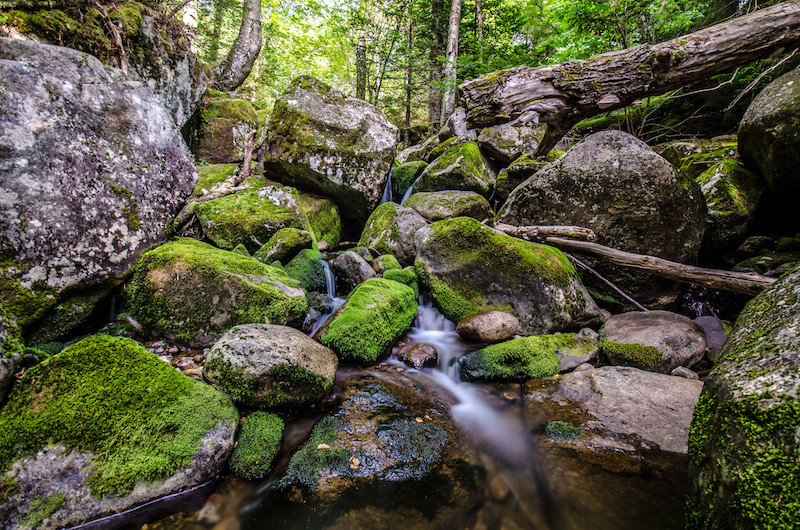Is Stacking Rocks Bad for the environment and potentially harmful to ecosystems? Yes, stacking rocks, while seemingly harmless, can negatively impact delicate ecosystems. At rockscapes.net, we delve into the environmental consequences of rock stacking and offer sustainable landscaping alternatives. We provide information and inspiration for creating beautiful, eco-conscious outdoor spaces with rock features. By the end of this article, you’ll understand the ecological effects of building rock piles and find eco-friendly ways to appreciate natural rock formations, including creative designs, natural stone selection, and responsible construction.
1. What is Rock Stacking and Why Do People Do It?
Is stacking rocks bad, and what motivates this practice? Rock stacking, or creating rock piles (cairns), is the act of balancing stones atop one another. People stack rocks for various reasons, including artistic expression, spiritual practice, meditation, or simply to mark a trail. However, this seemingly harmless activity can have detrimental effects on the environment.
- Artistic Expression: Many individuals view rock stacking as a form of land art, using natural materials to create temporary sculptures.
- Spiritual Practice: In some cultures, stacking rocks is a meditative practice, believed to promote balance and mindfulness.
- Trail Marking: Historically, cairns have been used to mark trails, especially in mountainous or barren landscapes.
2. What Are The Environmental Impacts of Rock Stacking?
Is stacking rocks bad from an environmental perspective? Absolutely. Removing and stacking rocks disturbs habitats, disrupts natural processes, and can lead to soil erosion. Here’s a closer look at the specific environmental impacts:
- Habitat Disruption: Rocks provide shelter and habitat for various organisms, including insects, amphibians, and small mammals. Moving these rocks can destroy their homes and disrupt their natural behavior.
- Soil Erosion: Removing rocks can expose soil to wind and water, increasing the risk of erosion, especially in sensitive areas like riverbanks and slopes.
- Impact on Aquatic Ecosystems: In rivers and streams, rocks provide essential habitat for fish and aquatic invertebrates. Disturbing these rocks can alter water flow, destroy spawning grounds, and disrupt the food chain.
- Aesthetic Pollution: While some find rock stacks aesthetically pleasing, others view them as a form of visual pollution, detracting from the natural beauty of the landscape.
 Rock stacks disrupting a natural riverbed ecosystem
Rock stacks disrupting a natural riverbed ecosystem
3. How Does Rock Stacking Affect Wildlife?
Is stacking rocks bad for local wildlife? Yes, it can significantly impact various species that depend on rocks for their survival.
- Insects: Many insects live under rocks, where they find shelter and food. Moving these rocks can expose them to predators and harsh environmental conditions.
- Amphibians: Salamanders and other amphibians rely on rocks for moisture and protection. Disturbing their habitat can lead to dehydration and increased vulnerability.
 Eastern newt, a native salamander that lives under river rocks
Eastern newt, a native salamander that lives under river rocks
- Fish: As noted by the Leave No Trace Center for Outdoor Ethics, fish often lay eggs in the crevices between rocks, and moving them can result in altered flows, which could wash away the eggs or expose the fry to predators.
- Macroinvertebrates: Every single rock is potentially a home to the larval stages of aquatic insects, including dragonflies, damselflies, mayflies, stoneflies, and caddisflies, and many others. They cling to rocks and capture drifting food particles. By moving and stacking rocks, the insects that are attached to or living on the rocks can be desiccated and burned by the sun.
 Caddisflies utilizing river rocks to build webs that catch drifting food particles
Caddisflies utilizing river rocks to build webs that catch drifting food particles
4. Are There Ethical Considerations Related to Rock Stacking?
Is stacking rocks bad from an ethical standpoint? Many argue that it violates the principles of Leave No Trace ethics, which aim to minimize human impact on the environment. These ethics encourage visitors to leave natural areas as they found them, preserving the experience for others and protecting the ecosystem.
- Leave No Trace Principles: Stacking rocks goes against the Leave No Trace principle of leaving natural areas undisturbed.
- Impact on Others’ Experience: Rock stacks can detract from the natural beauty and sense of discovery for other visitors.
5. What Does the Leave No Trace Center Say About Rock Stacking?
Is stacking rocks bad according to Leave No Trace principles? The Leave No Trace Center for Outdoor Ethics explicitly addresses rock stacking, advising against it in most situations. The organization emphasizes the importance of leaving natural areas as they are found, minimizing human impact, and respecting wildlife habitats. Here are their recommendations:
- Leave What You Find: Officially designated cairns need to be left in place. Altering these cairns in any way poses a threat to visitor safety, and the ethic of the area visiting.
- Stick to Durable Surfaces: When making your own rock stacks stick to durable surfaces. Many times along streams and rivers, one will be walking in riparian areas. Use designated trails and durable surfaces to minimize impacts.
- Collect Rocks Responsibly: When collecting rocks only collect ones that are loose from soils, sands, and silts. This will minimize the impact of erosion.
- Restore the Environment: Build your stacks, take pictures, and then return all of the used rocks to their original locations.
- Maintain Wildness: Leave the area how it was originally found to maintain the wildness of the area. Pack out all trash, including food scraps.
6. Where is Rock Stacking Most Damaging?
Is stacking rocks bad in all locations, or are some areas more vulnerable? Rock stacking is particularly damaging in sensitive ecosystems such as:
- Riparian Areas: Rivers and streams are home to diverse aquatic life, and disturbing rocks can disrupt these delicate ecosystems.
- Alpine Zones: High-altitude environments are fragile and slow to recover from disturbance.
- Arid Regions: Deserts and other arid landscapes have limited resources, and disturbing rocks can exacerbate erosion and habitat loss.
7. How Can We Reconcile Artistic Expression With Environmental Responsibility?
Is stacking rocks bad, even if it’s done with good intentions? While the intention may be harmless, the impact can be detrimental. Fortunately, there are alternative ways to express creativity and connect with nature without harming the environment:
- Photography: Capture the beauty of natural rock formations without altering them.
- Nature Art: Create art using leaves, twigs, and other natural materials without disturbing the landscape.
- Meditation: Practice mindfulness and connect with nature through meditation without leaving a physical trace.
- Sustainable Landscaping: Design rock gardens and water features that mimic natural ecosystems and provide habitat for wildlife, as showcased on rockscapes.net.
 Finding art and personal connections in nature without moving rocks
Finding art and personal connections in nature without moving rocks
8. What are the Alternatives to Rock Stacking for Trail Marking?
Is stacking rocks bad when used for trail marking? Yes, especially when it leads to the construction of unofficial cairns. Consider these alternatives:
- Using Existing Natural Features: Utilize existing trees, rock outcrops, or other natural landmarks to mark trails.
- Installing Official Trail Markers: Work with land managers to install durable, official trail markers that minimize environmental impact.
- GPS Navigation: Use GPS devices or smartphone apps to navigate trails, reducing the need for physical markers.
9. What are the Benefits of Leaving Rocks Undisturbed?
Is stacking rocks bad when considering the overall health of the ecosystem? Absolutely. Leaving rocks undisturbed helps maintain the natural balance of ecosystems and preserves habitats for wildlife.
- Habitat Preservation: Rocks provide shelter and breeding grounds for various species.
- Erosion Control: Rocks help stabilize soil and prevent erosion, especially in sensitive areas.
- Natural Beauty: Undisturbed landscapes retain their natural beauty and provide a more authentic experience for visitors.
10. How Can Rockscapes.Net Help You Create a Sustainable Rock Garden?
Is stacking rocks bad in your backyard? It’s less impactful, but there are still sustainable ways to incorporate rocks into your landscape. At rockscapes.net, we offer a wealth of information and resources for creating beautiful, eco-friendly rock gardens and water features.
- Sustainable Design: Our design guides emphasize the use of native plants, water conservation techniques, and responsible sourcing of materials.
- Expert Advice: Our team of landscape architects and horticulturists can provide personalized recommendations for creating a sustainable rock garden that meets your needs and preferences.
- Inspiration and Ideas: Explore our extensive photo gallery and project showcases for inspiration and ideas for your own rock garden.
11. What Types of Rocks Are Suitable for Landscaping?
Is stacking rocks bad when you’re using the wrong type of rock? The type of rock you use in your landscaping can significantly impact the environment. Here are some sustainable options:
- Locally Sourced Rocks: Using rocks sourced from nearby quarries or suppliers reduces transportation costs and environmental impact.
- Reclaimed Rocks: Reusing rocks from demolition sites or other sources is a great way to reduce waste and conserve resources.
- Native Rocks: Choosing rocks that are native to your region helps create a more natural and ecologically appropriate landscape.
12. How Can You Source Rocks Responsibly?
Is stacking rocks bad if you’re not sourcing them ethically? Responsible sourcing is crucial for minimizing the environmental impact of rock landscaping.
- Choose Reputable Suppliers: Select suppliers who follow sustainable mining practices and prioritize environmental protection.
- Ask About Origin: Inquire about the origin of the rocks and ensure they were extracted in an environmentally responsible manner.
- Avoid Sensitive Areas: Never collect rocks from protected areas or sensitive ecosystems.
13. What Are Some Sustainable Landscaping Techniques for Rock Gardens?
Is stacking rocks bad, or is it possible to create a rock garden responsibly? Here are some techniques for creating sustainable rock gardens:
- Use Native Plants: Incorporate native plants that are adapted to your local climate and soil conditions.
- Conserve Water: Implement water-wise irrigation techniques, such as drip irrigation or xeriscaping.
- Create Habitat: Design your rock garden to provide habitat for wildlife, such as birds, butterflies, and beneficial insects.
- Minimize Disturbance: Avoid disturbing the soil and vegetation as much as possible during construction.
14. How Can You Create a Natural-Looking Rock Garden?
Is stacking rocks bad when it results in an unnatural-looking landscape? Here are some tips for creating a rock garden that mimics natural rock formations:
- Observe Natural Landscapes: Study natural rock formations in your area and try to replicate them in your garden.
- Use a Variety of Rock Sizes and Shapes: Incorporate rocks of different sizes, shapes, and textures to create a more natural look.
- Arrange Rocks Intuitively: Arrange rocks in a way that feels natural and organic, rather than overly structured or symmetrical.
15. What Are Some Low-Maintenance Rock Garden Ideas?
Is stacking rocks bad when you could be creating a low-maintenance rock garden? Here are some ideas for creating a rock garden that requires minimal upkeep:
- Choose Drought-Tolerant Plants: Select plants that can thrive in dry conditions and require little watering.
- Use Mulch: Apply a layer of mulch around plants to suppress weeds and retain moisture.
- Incorporate Gravel or Stone Pathways: Use gravel or stone pathways to reduce the need for mowing and weeding.
- Design for Drainage: Ensure that your rock garden has good drainage to prevent waterlogging and root rot.
16. How Can You Incorporate Water Features Into a Rock Garden?
Is stacking rocks bad when you could be building a beautiful water feature? Water features can add beauty and interest to a rock garden while also providing habitat for wildlife.
- Ponds: Create a small pond with rocks around the edges to provide habitat for aquatic plants and animals.
- Waterfalls: Build a small waterfall or cascade using rocks to create a soothing sound and visual element.
- Streams: Design a meandering stream that flows through your rock garden, providing water for plants and wildlife.
17. What Safety Precautions Should You Take When Working With Rocks?
Is stacking rocks bad if you’re not taking proper safety precautions? Here are some safety tips for working with rocks:
- Wear Gloves: Protect your hands from cuts and abrasions by wearing gloves.
- Lift With Your Legs: Use proper lifting techniques to avoid back injuries.
- Use Safety Glasses: Protect your eyes from flying debris by wearing safety glasses.
- Work With a Partner: Enlist the help of a partner when moving heavy rocks.
18. What are the Benefits of Hiring a Professional Landscaper?
Is stacking rocks bad when you could have a professional create a stunning landscape? Hiring a professional landscaper can ensure that your rock garden is designed and installed correctly, minimizing environmental impact and maximizing aesthetic appeal.
- Expertise: Professional landscapers have the knowledge and experience to create sustainable, beautiful rock gardens.
- Efficiency: Landscapers can complete the project quickly and efficiently, saving you time and effort.
- Quality: Landscapers use high-quality materials and construction techniques to ensure that your rock garden lasts for years to come.
19. How Can Rockscapes.Net Help You Find a Qualified Landscaper?
Is stacking rocks bad when you’re unsure how to find a qualified professional? At rockscapes.net, we can connect you with qualified landscapers in your area who specialize in sustainable rock garden design and installation.
- Extensive Network: We have a network of experienced landscapers across the country who are committed to environmental responsibility.
- Vetted Professionals: We carefully vet all of our landscapers to ensure they meet our high standards for quality and professionalism.
- Personalized Recommendations: We can provide personalized recommendations based on your specific needs and preferences.
20. What Are Some Resources for Learning More About Sustainable Landscaping?
Is stacking rocks bad because you’re unaware of sustainable landscaping options? Here are some resources for learning more about sustainable landscaping:
- Rockscapes.net: Explore our website for articles, guides, and resources on sustainable rock garden design and installation.
- Local Nurseries: Visit your local nurseries and garden centers to learn about native plants and sustainable landscaping techniques.
- Online Forums: Participate in online forums and communities dedicated to sustainable landscaping to connect with other enthusiasts and experts.
21. Are There Any Situations Where Rock Stacking Is Acceptable?
Is stacking rocks bad in every single scenario? While generally discouraged, there are a few exceptions where rock stacking may be acceptable:
- Official Cairns: As noted by the Leave No Trace Center for Outdoor Ethics, officially designated cairns that are used for navigation should be left in place and maintained.
- Private Property: On your own private property, you have more freedom to create rock stacks, but it’s still important to consider the environmental impact.
- Educational Purposes: Rock stacking may be acceptable for educational purposes, such as teaching children about balance and geometry, but it should be done responsibly and with minimal impact.
22. How Can You Educate Others About the Impacts of Rock Stacking?
Is stacking rocks bad because people simply don’t know the consequences? Education is key to reducing the negative impacts of rock stacking.
- Share Information: Share articles, videos, and other resources about the environmental impacts of rock stacking with your friends, family, and social media followers.
- Lead by Example: Demonstrate responsible behavior by avoiding rock stacking and leaving natural areas as you found them.
- Engage in Dialogue: Engage in respectful dialogue with others who are stacking rocks and explain the reasons why it’s harmful.
- Support Conservation Organizations: Support organizations that are working to protect natural areas and educate the public about environmental issues.
23. What is the Role of Land Managers in Addressing Rock Stacking?
Is stacking rocks bad because land managers aren’t doing enough to prevent it? Land managers play a crucial role in addressing the issue of rock stacking.
- Education: Land managers can educate visitors about the impacts of rock stacking through signage, brochures, and outreach programs.
- Regulations: Land managers can implement regulations that prohibit rock stacking in sensitive areas.
- Enforcement: Land managers can enforce regulations through patrols and fines.
- Restoration: Land managers can restore areas that have been damaged by rock stacking by removing the stacks and replanting native vegetation.
24. How Does Climate Change Exacerbate the Impacts of Rock Stacking?
Is stacking rocks bad, especially in the context of climate change? Climate change is exacerbating the impacts of rock stacking by making ecosystems more vulnerable to disturbance.
- Increased Erosion: Climate change is leading to more frequent and intense storms, which can increase erosion in areas where rocks have been removed.
- Habitat Loss: Climate change is already causing habitat loss for many species, and rock stacking can further reduce available habitat.
- Species Extinction: Climate change is increasing the risk of species extinction, and rock stacking can contribute to this risk by disrupting ecosystems and reducing biodiversity.
25. What is the Future of Rock Stacking?
Is stacking rocks bad enough that it will eventually become a thing of the past? The future of rock stacking depends on our ability to educate the public about its impacts and promote responsible behavior.
- Increased Awareness: As more people become aware of the environmental impacts of rock stacking, it’s likely that the practice will decline.
- Sustainable Alternatives: As more sustainable alternatives to rock stacking become available, such as nature art and meditation, people may be more likely to adopt these practices.
- Regulations and Enforcement: As land managers implement more regulations and enforcement measures, rock stacking may become less common in protected areas.
26. How Can You Get Involved in Protecting Natural Areas?
Is stacking rocks bad, and what can you do to help protect natural areas? There are many ways to get involved in protecting natural areas:
- Volunteer: Volunteer your time with conservation organizations to help restore habitat, remove invasive species, and educate the public.
- Donate: Donate to conservation organizations to support their work in protecting natural areas.
- Advocate: Advocate for policies that protect natural areas and promote sustainable practices.
- Educate Yourself: Learn more about environmental issues and how you can make a difference.
27. What Resources Does Rockscapes.Net Offer for Sustainable Landscaping?
Is stacking rocks bad, and how can Rockscapes.Net help you find better options? At rockscapes.net, we provide a comprehensive range of resources for sustainable landscaping:
- Design Guides: Access detailed design guides that provide step-by-step instructions for creating sustainable rock gardens, water features, and other landscape elements.
- Plant Database: Explore our extensive plant database to find native plants that are well-suited to your local climate and soil conditions.
- Supplier Directory: Find reputable suppliers of sustainable landscaping materials, such as locally sourced rocks, reclaimed wood, and organic fertilizers.
- Expert Advice: Consult with our team of landscape architects and horticulturists to get personalized recommendations for your project.
- Project Showcases: Browse our project showcases to see examples of successful sustainable landscaping projects and get inspiration for your own.
Address: 1151 S Forest Ave, Tempe, AZ 85281, United States.
Phone: +1 (480) 965-9011.
Website: rockscapes.net.
28. What Are The Most Common Misconceptions About Rock Stacking?
Is stacking rocks bad because of misinformation? There are several common misconceptions about rock stacking:
- It’s Harmless: Many people believe that rock stacking is a harmless activity, but it can have significant environmental impacts.
- It’s a Tradition: While rock stacking has been used for trail marking in some cultures, the modern practice of stacking rocks for artistic or spiritual purposes is not a traditional practice.
- It’s Beneficial for the Environment: Some people believe that rock stacking is a way to connect with nature and improve the environment, but it actually harms ecosystems.
29. Can Rock Stacking Impact Archaeological Sites?
Is stacking rocks bad near archaeological sites? Yes, it can potentially impact archaeological sites.
- Disturbing Artifacts: Rock stacking can disturb or damage artifacts that may be buried beneath the surface.
- Altering Landscapes: Rock stacking can alter the appearance of archaeological sites, making them less recognizable and potentially confusing visitors.
- Erosion: Rock stacking can contribute to erosion, which can damage or destroy archaeological sites.
30. What Legal Restrictions Exist Regarding Rock Stacking?
Is stacking rocks bad from a legal perspective? In some areas, rock stacking may be subject to legal restrictions.
- Protected Areas: Rock stacking may be prohibited in protected areas, such as national parks, state parks, and wilderness areas.
- Permits: In some cases, you may need a permit to stack rocks on public land.
- Private Property: On private property, you have more freedom to stack rocks, but you may still be subject to local regulations regarding landscaping and environmental protection.
31. How Can Technology Help Reduce the Impacts of Rock Stacking?
Is stacking rocks bad when technology offers better alternatives? Technology can play a role in reducing the impacts of rock stacking.
- GPS Navigation: GPS devices and smartphone apps can be used to navigate trails, reducing the need for physical markers.
- Virtual Art: Digital art tools can be used to create virtual rock stacks without disturbing the environment.
- Online Education: Online platforms can be used to educate the public about the impacts of rock stacking and promote responsible behavior.
32. Is There a Difference Between Rock Balancing and Rock Stacking?
Is stacking rocks bad, or is it only rock balancing that’s harmful? While the terms are often used interchangeably, there is a subtle difference between rock balancing and rock stacking.
- Rock Balancing: Rock balancing typically involves creating precarious arrangements of rocks that are balanced on top of each other.
- Rock Stacking: Rock stacking involves creating more stable piles of rocks that are stacked on top of each other.
Both practices can have environmental impacts, but rock balancing may be more likely to disturb the immediate area around the rocks.
33. What Are Some Creative Alternatives to Rock Stacking?
Is stacking rocks bad when there are so many other creative options? Here are some creative alternatives to rock stacking that are less harmful to the environment:
- Nature Photography: Capture the beauty of natural landscapes through photography.
- Nature Journaling: Document your observations of nature in a journal.
- Land Art: Create art using natural materials without disturbing the landscape.
- Meditation: Practice mindfulness and connect with nature through meditation.
34. How Can We Promote Responsible Tourism in Natural Areas?
Is stacking rocks bad in the context of tourism? Responsible tourism is essential for protecting natural areas.
- Education: Educate tourists about the impacts of their actions on the environment.
- Regulations: Implement regulations that protect natural areas and promote sustainable practices.
- Enforcement: Enforce regulations through patrols and fines.
- Sustainable Practices: Encourage businesses and individuals to adopt sustainable practices.
35. What is the Connection Between Rock Stacking and Spiritual Practices?
Is stacking rocks bad, even if it’s part of someone’s spiritual practice? While rock stacking may be part of some spiritual practices, it’s important to consider the environmental impacts.
- Respect for Nature: Many spiritual traditions emphasize the importance of respecting nature and living in harmony with the environment.
- Mindfulness: Mindfulness can be practiced in many ways that don’t involve disturbing the environment.
- Alternative Practices: Consider alternative spiritual practices that are less harmful to the environment, such as meditation, yoga, or nature walks.
36. What is the Economic Impact of Rock Stacking?
Is stacking rocks bad for the economy? While the economic impact of rock stacking may not be immediately obvious, it can have indirect consequences.
- Tourism: Rock stacking can detract from the natural beauty of landscapes, which can negatively impact tourism.
- Environmental Damage: Rock stacking can contribute to environmental damage, which can be costly to repair.
- Resource Depletion: Rock stacking can lead to resource depletion, which can have long-term economic consequences.
37. How Can Businesses Promote Sustainable Landscaping Practices?
Is stacking rocks bad for businesses to encourage? Businesses can play a role in promoting sustainable landscaping practices.
- Sustainable Design: Incorporate sustainable design principles into their landscaping projects.
- Native Plants: Use native plants that are well-suited to the local climate and soil conditions.
- Water Conservation: Implement water-wise irrigation techniques.
- Responsible Sourcing: Source materials from reputable suppliers who follow sustainable practices.
38. How Can Schools Educate Students About the Impacts of Rock Stacking?
Is stacking rocks bad to do as a school activity? Schools can educate students about the impacts of rock stacking.
- Environmental Education: Incorporate environmental education into the curriculum.
- Field Trips: Organize field trips to natural areas to teach students about ecosystems and the importance of conservation.
- Hands-On Activities: Engage students in hands-on activities that promote environmental stewardship.
- Guest Speakers: Invite guest speakers from conservation organizations to talk to students about environmental issues.
39. Are There any Citizen Science Projects Related to Rock Stacking?
Is stacking rocks bad, and are there any studies about it? While there may not be specific citizen science projects focused solely on rock stacking, related projects could include:
- Habitat Monitoring: Participate in citizen science projects that monitor habitats and wildlife populations in areas where rock stacking is common.
- Erosion Monitoring: Participate in citizen science projects that monitor erosion rates in sensitive areas.
- Water Quality Monitoring: Participate in citizen science projects that monitor water quality in rivers and streams.
40. What is the Ultimate Message About Rock Stacking?
Is stacking rocks bad? The ultimate message about rock stacking is that it’s important to consider the environmental impacts of our actions and to practice responsible behavior in natural areas. While rock stacking may seem like a harmless activity, it can have significant consequences for ecosystems and wildlife. By educating ourselves and others, we can protect the natural beauty of our planet for future generations.
Visit rockscapes.net today to discover sustainable landscaping solutions, explore stunning rock garden designs, and connect with expert landscape architects who can bring your vision to life while respecting the environment. Transform your outdoor space into a haven of natural beauty without harming the delicate ecosystems around you. Let rockscapes.net be your guide to creating a sustainable and breathtaking landscape.
